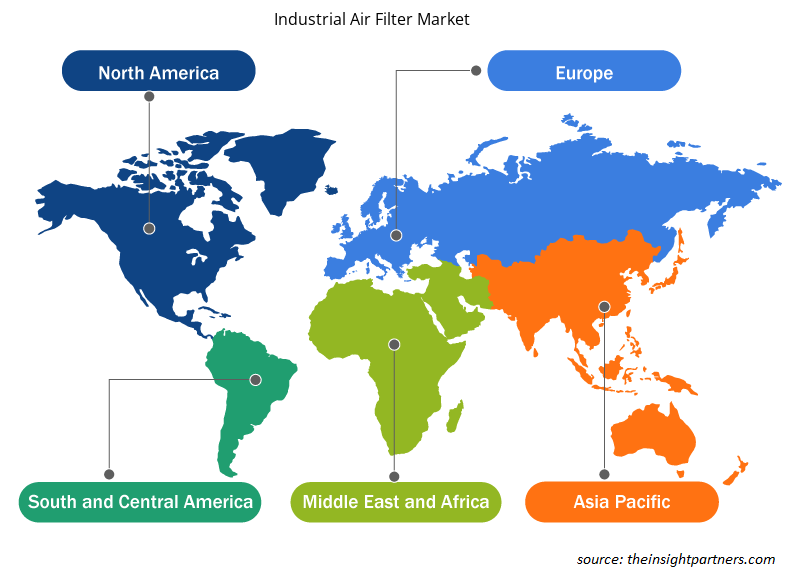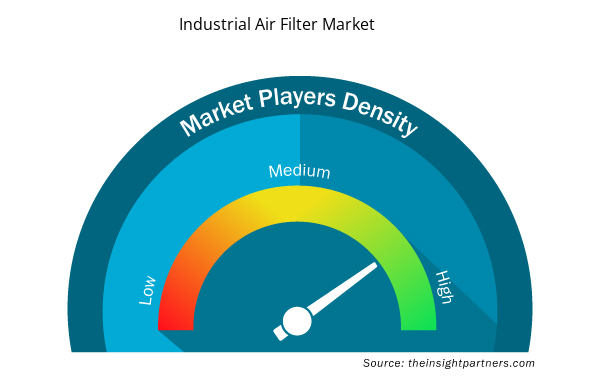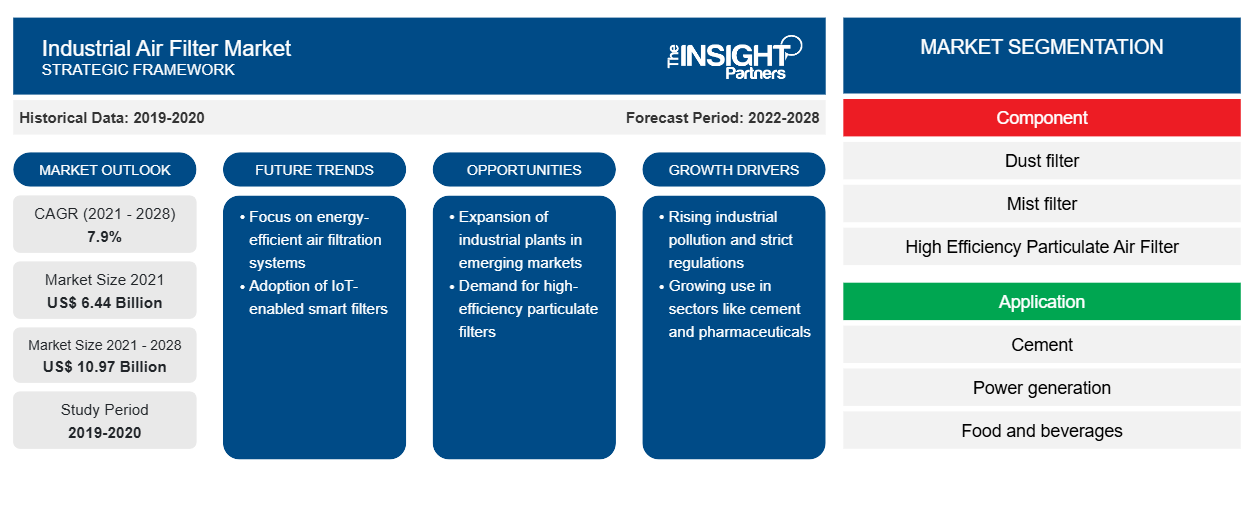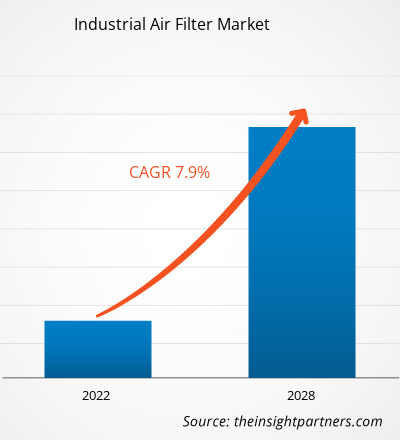[Forschungsbericht] Der Markt für industrielle Luftfilter soll von 6,44 Milliarden US-Dollar im Jahr 2021 auf 10,97 Milliarden US-Dollar im Jahr 2028 wachsen; für den Zeitraum 2021–2028 wird eine durchschnittliche jährliche Wachstumsrate (CAGR) von 7,9 % geschätzt.
Analystenperspektive:
Der Markt für industrielle Luftfilter ist in den letzten Jahren stark gewachsen und hat sich ausgeweitet. Dies ist auf mehrere Schlüsselfaktoren zurückzuführen, die die Nachfrage nach Luftfiltersystemen in industriellen Umgebungen antreiben. Einer der Haupttreiber ist das rasante Tempo der Industrialisierung in verschiedenen Sektoren weltweit. Mit der Expansion der Industrie und der Intensivierung der Produktionsprozesse nehmen die Schadstoffe und Verunreinigungen in der Luft zu. Dies erfordert die Implementierung wirksamer Luftfiltersysteme, um eine optimale Luftqualität aufrechtzuerhalten und die Gesundheit der Arbeitnehmer zu schützen. Ein weiterer wichtiger Faktor, der zum Wachstum des Marktes beiträgt, ist die Verschärfung der Luftqualitätsstandards und -vorschriften von Regierungen und Umweltbehörden. Diese Vorschriften zielen darauf ab, die Emissionen und Schadstoffe, die durch industrielle Betriebe in die Atmosphäre freigesetzt werden, zu minimieren. Daher sind die Industrien gezwungen, in fortschrittliche Luftfiltertechnologien zu investieren, um diese strengen Standards einzuhalten.
Darüber hinaus wächst bei den Industrieunternehmen das Bewusstsein für die nachteiligen Auswirkungen einer schlechten Luftqualität auf die Produktivität, das Wohlbefinden der Arbeitnehmer und die allgemeine Betriebseffizienz. Industrielle Luftfilter spielen eine entscheidende Rolle bei der Entfernung schädlicher Partikel aus der Luft wie Staub, Rauch, Chemikalien und Allergene und sorgen so für eine gesündere und sicherere Arbeitsumgebung. Der Markt für industrielle Luftfilter umfasst verschiedene Produkte für unterschiedliche Industriezweige, darunter Fertigung, Automobilindustrie, Pharmazie, Lebensmittelverarbeitung, Chemieanlagen und Elektronik. Diese Filter unterscheiden sich in Größe, Effizienz und Technologie, je nach den spezifischen Anforderungen der einzelnen Branchen.
Marktübersicht:
Um die Qualität der Luft im Innen- und Außenbereich zu verbessern, reduzieren oder entfernen Luftfilter Verunreinigungen aus der Luft. Jedes Heizungs-, Lüftungs- und Klimaanlagensystem benötigt industrielle Luftfilter, um Fremdpartikel aus der Luft zu entfernen. Industrielle Luftfilter sind in jedem Unternehmen von entscheidender Bedeutung, in dem Prozesse Rauch und Schadstoffe erzeugen. Diese Filter erhalten die Luftqualität in geschlossenen Räumen (IAQ), indem sie Schadstoffe wie Pollen, Staub und chemische Schadstoffe herausfiltern. Industrielle Luftfilter verhindern auch, dass Schadstoffe in Industriemaschinen gelangen , und verringern so das Risiko von Maschinenschäden durch große Fremdpartikel.
Passen Sie diesen Bericht Ihren Anforderungen an
Sie erhalten kostenlos individuelle Anpassungen an jedem Bericht, einschließlich Teilen dieses Berichts oder einer Analyse auf Länderebene, eines Excel-Datenpakets sowie tolle Angebote und Rabatte für Start-ups und Universitäten.
- Holen Sie sich die wichtigsten Markttrends aus diesem Bericht.Dieses KOSTENLOSE Beispiel umfasst eine Datenanalyse von Markttrends bis hin zu Schätzungen und Prognosen.
Markttreiber:
Wachsendes Gesundheits- und Sicherheitsbewusstsein treibt Wachstum im Markt für industrielle Luftfilter voran
Das wachsende Bewusstsein für Gesundheit und Sicherheit in industriellen Umgebungen spielt eine bedeutende Rolle beim Wachstum des Marktes für industrielle Luftfilter. Da sich Organisationen und Industrien der Auswirkungen der Luftqualität auf das Wohlbefinden und die Sicherheit ihrer Mitarbeiter immer bewusster werden, wird der Schaffung sauberer und gesunder Innenräume ein höherer Stellenwert beigemessen. Dieses Bewusstsein führt zu einer erhöhten Nachfrage nach wirksamen Luftfiltersystemen und fördert so das Marktwachstum. Organisationen legen Wert auf das Wohlbefinden ihrer Mitarbeiter und erkennen, dass schlechte Luftqualität zu Atemproblemen, Allergien und Berufskrankheiten führen kann. Durch Investitionen in hochwertige Luftfiltersysteme wollen Unternehmen die Luftqualität in Innenräumen verbessern und ihren Mitarbeitern eine sichere Arbeitsumgebung bieten. Dieser Fokus auf das Wohlbefinden der Mitarbeiter treibt die Nachfrage nach industriellen Luftfiltern an und trägt zum Marktwachstum bei.
Regierungen und Aufsichtsbehörden erlassen strenge Arbeitsschutzvorschriften. Diese Vorschriften enthalten häufig spezifische Anforderungen zur Einhaltung akzeptabler Luftqualitätsstandards in industriellen Umgebungen. Unternehmen müssen diese Vorschriften einhalten, um Strafen und rechtliche Verpflichtungen zu vermeiden. Es besteht eine wachsende Nachfrage nach effektiven Luftfiltersystemen, um diese Konformitätsanforderungen zu erfüllen, was das Marktwachstum weiter vorantreibt. Eine saubere und gesunde Raumluftqualität wirkt sich auch direkt auf die Produktivität der Mitarbeiter und die allgemeine Betriebseffizienz aus. Wenn Mitarbeiter sauberer Luft ausgesetzt sind, haben sie weniger gesundheitliche Probleme, sind weniger müde und können sich besser konzentrieren. Unternehmen haben dies erkannt und investieren in industrielle Luftfilter, um die Leistung ihrer Belegschaft zu optimieren und so letztendlich die Produktivität und Betriebseffizienz zu verbessern.
Darüber hinaus können Unternehmen, die der Gesundheit und Sicherheit ihrer Mitarbeiter höchste Priorität einräumen, einen positiven Ruf und ein positives Markenimage aufbauen. Verbraucher, Investoren und Talente sind zunehmend geneigt, Unternehmen zu unterstützen, die sich dem Wohlbefinden ihrer Mitarbeiter und der ökologischen Nachhaltigkeit verschrieben haben. Durch Investitionen in fortschrittliche Luftfiltersysteme zur Gewährleistung einer sauberen und gesunden Arbeitsumgebung können Unternehmen ihren Ruf verbessern und sich einen Wettbewerbsvorteil auf dem Markt verschaffen. Das wachsende Bewusstsein für Gesundheit und Sicherheit in industriellen Umgebungen spiegelt auch die veränderten Verbraucherpräferenzen wider. Verbraucher achten heute stärker auf die Produkte, die sie kaufen, und die Unternehmen, die sie unterstützen. Sie bevorzugen Unternehmen, die dem Wohlbefinden ihrer Mitarbeiter und der Verantwortung für die Umwelt höchste Priorität einräumen. Daher können Unternehmen, die sich der Gewährleistung einer sauberen und gesunden Luftqualität durch industrielle Luftfilter verschrieben haben, auf diese Verbraucherpräferenzen eingehen und sich so positiv auf dem Markt positionieren.
Segmentanalyse:
Basierend auf dem Produkt ist der Markt für industrielle Luftfilter in Staubfilter, Nebelfilter, Schlauchfilter, Patronensammler und -filter (CC und F), HEPA-Filter, Nasswäscher und Trockenwäscher unterteilt. Das Segment der Nasswäscher hatte im Jahr 2020 den größten Marktanteil und wird im Prognosezeitraum voraussichtlich die höchste durchschnittliche jährliche Wachstumsrate auf dem Markt verzeichnen. Nasswäscher haben sich aus mehreren Gründen zum dominierenden Marktsegment für industrielle Luftfilter entwickelt. Sie bieten eine hohe Effizienz bei der Entfernung von Schadstoffen, sind branchenübergreifend vielseitig einsetzbar und erfüllen strenge Emissionsvorschriften. Nasswäscher beseitigen gefährliche Stoffe effektiv und kontrollieren Partikel, was sie zu einer bevorzugten Wahl für verschiedene Industriezweige macht. Technologische Fortschritte, Kosteneffizienz und langfristige Vorteile dominieren ihren Markt weiterhin. Insgesamt haben die umfassenden Fähigkeiten der Nasswäscher zur Schadstoffentfernung und ihre weit verbreiteten Anwendungen ihre Position als führende Lösung auf dem Markt für industrielle Luftfilter gesichert.
Regionale Analyse:
Der nordamerikanische Markt für industrielle Luftfilter wurde im Jahr 2021 auf 2,10 Milliarden US-Dollar geschätzt und soll bis 2028 3,45 Millionen US-Dollar erreichen; im Prognosezeitraum wird ein durchschnittliches jährliches Wachstum von 7,4 % erwartet. Die nordamerikanische Region hat sich zum dominierenden Markt in der Industrie für industrielle Luftfilter entwickelt, was hauptsächlich auf mehrere Schlüsselfaktoren zurückzuführen ist, die zu ihrer führenden Position beitragen. Erstens ist Nordamerika dafür bekannt, strenge Umweltschutzbestimmungen umzusetzen, insbesondere in Ländern wie den Vereinigten Staaten und Kanada. Diese Bestimmungen zielen darauf ab, die Luftverschmutzung zu kontrollieren und zu reduzieren, die Luftqualität zu verbessern und die öffentliche Gesundheit zu schützen. Die Industriezweige in Nordamerika müssen diese strengen Emissionsstandards einhalten, was die Nachfrage nach fortschrittlichen Luftfiltertechnologien antreibt. Unternehmen in der Region legen Wert auf die Einhaltung dieser Bestimmungen, was zu einer höheren Akzeptanzrate von industriellen Luftfiltern führt. Zweitens verfügt Nordamerika über einen gut entwickelten und vielfältigen Industriezweig. Die hohe Industrialisierung und Industrieaktivität in Nordamerika führt dazu, dass erhebliche Emissionen und Schadstoffe in die Atmosphäre freigesetzt werden. Um Umweltbedenken auszuräumen und die Gesundheit der Arbeitnehmer zu schützen, investieren Industrien in Nordamerika in moderne Luftfiltersysteme. Daher ist die Nachfrage nach industriellen Luftfiltern in dieser Region höher als in anderen.
Darüber hinaus zeichnet sich Nordamerika durch eine Kultur des technologischen Fortschritts und der Innovation aus. Die Region verfügt über eine robuste Forschungs- und Entwicklungsinfrastruktur, die die kontinuierliche Entwicklung hochmoderner Luftfiltertechnologien ermöglicht. Hersteller in Nordamerika sind führend bei der Entwicklung und Vermarktung fortschrittlicher Filterlösungen, die hohe Effizienz und verbesserte Leistung bieten. Diese technologische Führungsrolle verschafft nordamerikanischen Unternehmen einen Wettbewerbsvorteil und trägt zur Dominanz der Region auf dem Markt für industrielle Luftfilter bei. Darüber hinaus war das wachsende Bewusstsein für die Bedeutung der Luftqualität in Nordamerika eine treibende Kraft hinter der zunehmenden Einführung industrieller Luftfilter. Sowohl Industrie als auch Privatpersonen erkennen zunehmend die gesundheitlichen und ökologischen Vorteile sauberer Luft. Dieses gesteigerte Bewusstsein hat zu einer größeren Nachfrage nach Luftfilterlösungen geführt und das Marktwachstum in Nordamerika weiter vorangetrieben.
Schlüsselspieleranalyse:
Die Marktanalyse für Industrieluftfilter umfasst Akteure wie Honeywell International Inc, MANN+HUMMEL International GmbH & Co, Beko Technologies, Sentry Air Systems, Nordic Air Filteration A/S, Donaldson Company, Filtration Group Industrial, Pall Corporation, General Filter Italia und Camfil. Unter den Akteuren im Bereich Industrieluftfilter sind Honeywell International Inc und Donaldson Company aufgrund ihres diversifizierten Produktportfolios die beiden größten Akteure.
Regionale Einblicke in den Markt für industrielle Luftfilter
Die regionalen Trends und Faktoren, die den Markt für industrielle Luftfilter im Prognosezeitraum beeinflussen, wurden von den Analysten von Insight Partners ausführlich erläutert. In diesem Abschnitt werden auch die Marktsegmente und die Geografie industrieller Luftfilter in Nordamerika, Europa, im asiatisch-pazifischen Raum, im Nahen Osten und Afrika sowie in Süd- und Mittelamerika erörtert.

- Erhalten Sie regionale Daten zum Markt für industrielle Luftfilter
Umfang des Marktberichts für industrielle Luftfilter
| Berichtsattribut | Details |
|---|---|
| Marktgröße im Jahr 2021 | 6,44 Milliarden US-Dollar |
| Marktgröße bis 2028 | 10,97 Milliarden US-Dollar |
| Globale CAGR (2021 - 2028) | 7,9 % |
| Historische Daten | 2019-2020 |
| Prognosezeitraum | 2022–2028 |
| Abgedeckte Segmente | Nach Komponente
|
| Abgedeckte Regionen und Länder | Nordamerika
|
| Marktführer und wichtige Unternehmensprofile |
|
Dichte der Marktteilnehmer für industrielle Luftfilter: Verständnis ihrer Auswirkungen auf die Geschäftsdynamik
Der Markt für industrielle Luftfilter wächst rasant, angetrieben durch die steigende Nachfrage der Endverbraucher aufgrund von Faktoren wie sich entwickelnden Verbraucherpräferenzen, technologischen Fortschritten und einem größeren Bewusstsein für die Vorteile des Produkts. Mit steigender Nachfrage erweitern Unternehmen ihr Angebot, entwickeln Innovationen, um die Bedürfnisse der Verbraucher zu erfüllen, und nutzen neue Trends, was das Marktwachstum weiter ankurbelt.
Die Marktteilnehmerdichte bezieht sich auf die Verteilung der Firmen oder Unternehmen, die in einem bestimmten Markt oder einer bestimmten Branche tätig sind. Sie gibt an, wie viele Wettbewerber (Marktteilnehmer) in einem bestimmten Marktraum im Verhältnis zu seiner Größe oder seinem gesamten Marktwert präsent sind.
Die wichtigsten auf dem Markt für industrielle Luftfilter tätigen Unternehmen sind:
- Honeywell International, Inc.
- Mann + Hummel GmbH
- NORDIC AIR FILTRATION
- Donaldson Company, Inc
- ALLGEMEINER FILTER ITALIEN
Haftungsausschluss : Die oben aufgeführten Unternehmen sind nicht in einer bestimmten Reihenfolge aufgeführt.

- Überblick über die wichtigsten Akteure auf dem Markt für industrielle Luftfilter
Aktuelle Entwicklungen:
Anorganische und organische Strategien wie Fusionen und Übernahmen werden von Unternehmen auf dem Markt für industrielle Luftfilter häufig eingesetzt. Nachfolgend sind einige aktuelle wichtige Marktentwicklungen aufgeführt:
- Im November 2021 hat Alfa Laval sein LNG-Portfolio mit der Gasverbrennungseinheit 2.0 erweitert. Diese neue Investition wird dem Unternehmen helfen, sein Territorium auf mehrere Golfstaaten auszudehnen.
- Im September 2021 stellte Eaton ein neues Zero-Leak Compact Combo Valve vor, das schädliche Kraftstoffdämpfe im Tank sicher ablässt, indem es ein Fill Limit Vent Valve (FLVV) und ein neues Zero-Leak Grade Vent Valve (GVV) stapelt.
- Historische Analyse (2 Jahre), Basisjahr, Prognose (7 Jahre) mit CAGR
- PEST- und SWOT-Analyse
- Marktgröße Wert/Volumen – Global, Regional, Land
- Branche und Wettbewerbsumfeld
- Excel-Datensatz


- Excimer & Femtosecond Ophthalmic Lasers Market
- Wind Turbine Composites Market
- Small Satellite Market
- Legal Case Management Software Market
- Industrial Inkjet Printers Market
- Digital Language Learning Market
- Sexual Wellness Market
- Print Management Software Market
- Lymphedema Treatment Market
- Hydrogen Storage Alloys Market

Report Coverage
Revenue forecast, Company Analysis, Industry landscape, Growth factors, and Trends

Segment Covered
This text is related
to segments covered.

Regional Scope
North America, Europe, Asia Pacific, Middle East & Africa, South & Central America

Country Scope
This text is related
to country scope.
Häufig gestellte Fragen
This demand is mainly driven by an end-user preference for environmentally friendly air filters to reduce industrial workers' health risks. Manufacturers are increasingly creating energy-efficient air filters, such as rigid cellular filters, pleated filters, and pocket filters, that is both efficient and simple to install. Clarcor, for example, is a market participant that produces high-efficiency HVAC filters and antimicrobial filters that work in all climates. Furthermore, the rising desire for better environmental conditions in the residential and commercial sectors may present profitable prospects for the industrial air filter market. Furthermore, Camfil introduced the Absolute V, an energy-efficient HEPA air filter, in February 2020. It saves 20% of the energy used. Moreover, In April 2020, Parker presents an energy-efficient HVAC filter. HVAC systems for food processing, microelectronics production, clean manufacturing facilities, hospitals and healthcare facilities, and industrial manufacturing use Parker QuadSEAL 4 in filters. Thus, increasing demand for energy-efficient and higher-performing air filtration technologies is expected to propel the industrial air filter market forward.
on the basis of application the market is sub-segmented into cement, food and beverages, metals, power generation, pharmaceutical, chemical, oil and gas, others. The power generations segment led the industrial air filter market.
Based on product, the market is segmented as Dust Filters, Mist Filters, Baghouse Filters, Cartridge Collectors and Filters (CC and F), HEPA Filters, Wet Scrubbers, Dry Scrubbers. The dry scrubbers segment led the industrial air filter market with a market share of XX% in 2020. Further, it is expected to garner XX% share by 2028
With rising levels of air pollution worldwide, regulatory bodies have implemented various clean air regulations, prompting several sectors to integrate air filter units into their systems, which is a driving factor for market growth. Increased industrialization worldwide, such as in the cement, metal processing, pharmaceutical, and chemical industries, is another element driving expansion. Pollutants are also managed and monitored as a result of growing environmental concerns that promote business expansion. Over time, high capital investment works as a stifling factor for sector competitiveness. Production and installation of such components into the system is a costly event, which impedes the industries' expansion.
The key companies operating in the field of industrial air filter market that are profiled in the report include Honeywell International Inc, MANN+HUMMEL International GmbH & Co, Beko Technologies, Sentry Air Systems, Nordic Air Filteration A/S, Donaldson Company, Filtration Group Industrial, Pall Corporation, General Filter Italia, Camfil among many others.
Some of the most recent filtration advancements are based on new developments in filter design and media technology, fueled by legislative responses to climate change and rising GHG emissions. Filtration system designers and plant managers can now reduce their operating costs and save energy while maintaining the highest quality standards and achieving a performance boost thanks to innovative filtration products. There are numerous advancements in air filtering technologies for industrial uses, including automotive and other industrial applications, profiling breakthroughs such as Capaceon, NANOWEB, NanoWave, Synteq XP, PowerCore, and Ultra-Web. For instance, Donaldson, a prominent global provider of filtration systems and replacement parts, recently introduced Synteq XP compressed air filter media, which the firm claims boosts efficiency while decreasing energy consumption by as much as 40% due to a much lower media delta pressure. Furthermore, Hollingsworth & Vose Company designed and developed NanoWave, an all-synthetic extended surface, high-loft material that is environmentally friendly. The material has three times the dirt retention capacity of standard media and was designed for the ASHRAE (American Society of Heating, Refrigeration, and Air Conditioning Engineers)-certified HVAC bag filter media market. Delta pressure levels are projected to fall more in the coming years as filtering efficiency is required. The pressure to satisfy increased environmental demands develops, and new inventions, such as advancements in nanotechnology, are introduced to the market. Moreover, inhibited oxidation, for instance, has various advantages in wet scrubbers, including low reagent cost, reduced reagent usage, and low overall life cycle cost. In the suppressed oxidation process, emulsified sulphur is added to the reagent feed tank, lowering the oxidation rate to less than 15% and permitting the use of less expensive materials by removing the corrosion mechanism. Thus, the market for industrial air filter is expected to be driven by such advanced technologies and tools.
Trends and growth analysis reports related to Manufacturing and Construction : READ MORE..
The List of Companies - Industrial Air Filter Market
- Honeywell International, Inc.
- Mann + Hummel GmbH
- NORDIC AIR FILTRATION
- Donaldson Company, Inc
- GENERAL FILTER ITALIA
- Camfil AB
- Paul Corporation
- FILTRATION GROUP INDUSTRIAL
- SENTRY AIR SYSTEMS, INC
- AIR FILTERS, INC.
The Insight Partners performs research in 4 major stages: Data Collection & Secondary Research, Primary Research, Data Analysis and Data Triangulation & Final Review.
- Data Collection and Secondary Research:
As a market research and consulting firm operating from a decade, we have published and advised several client across the globe. First step for any study will start with an assessment of currently available data and insights from existing reports. Further, historical and current market information is collected from Investor Presentations, Annual Reports, SEC Filings, etc., and other information related to company’s performance and market positioning are gathered from Paid Databases (Factiva, Hoovers, and Reuters) and various other publications available in public domain.
Several associations trade associates, technical forums, institutes, societies and organization are accessed to gain technical as well as market related insights through their publications such as research papers, blogs and press releases related to the studies are referred to get cues about the market. Further, white papers, journals, magazines, and other news articles published in last 3 years are scrutinized and analyzed to understand the current market trends.
- Primary Research:
The primarily interview analysis comprise of data obtained from industry participants interview and answers to survey questions gathered by in-house primary team.
For primary research, interviews are conducted with industry experts/CEOs/Marketing Managers/VPs/Subject Matter Experts from both demand and supply side to get a 360-degree view of the market. The primary team conducts several interviews based on the complexity of the markets to understand the various market trends and dynamics which makes research more credible and precise.
A typical research interview fulfils the following functions:
- Provides first-hand information on the market size, market trends, growth trends, competitive landscape, and outlook
- Validates and strengthens in-house secondary research findings
- Develops the analysis team’s expertise and market understanding
Primary research involves email interactions and telephone interviews for each market, category, segment, and sub-segment across geographies. The participants who typically take part in such a process include, but are not limited to:
- Industry participants: VPs, business development managers, market intelligence managers and national sales managers
- Outside experts: Valuation experts, research analysts and key opinion leaders specializing in the electronics and semiconductor industry.
Below is the breakup of our primary respondents by company, designation, and region:

Once we receive the confirmation from primary research sources or primary respondents, we finalize the base year market estimation and forecast the data as per the macroeconomic and microeconomic factors assessed during data collection.
- Data Analysis:
Once data is validated through both secondary as well as primary respondents, we finalize the market estimations by hypothesis formulation and factor analysis at regional and country level.
- Macro-Economic Factor Analysis:
We analyse macroeconomic indicators such the gross domestic product (GDP), increase in the demand for goods and services across industries, technological advancement, regional economic growth, governmental policies, the influence of COVID-19, PEST analysis, and other aspects. This analysis aids in setting benchmarks for various nations/regions and approximating market splits. Additionally, the general trend of the aforementioned components aid in determining the market's development possibilities.
- Country Level Data:
Various factors that are especially aligned to the country are taken into account to determine the market size for a certain area and country, including the presence of vendors, such as headquarters and offices, the country's GDP, demand patterns, and industry growth. To comprehend the market dynamics for the nation, a number of growth variables, inhibitors, application areas, and current market trends are researched. The aforementioned elements aid in determining the country's overall market's growth potential.
- Company Profile:
The “Table of Contents” is formulated by listing and analyzing more than 25 - 30 companies operating in the market ecosystem across geographies. However, we profile only 10 companies as a standard practice in our syndicate reports. These 10 companies comprise leading, emerging, and regional players. Nonetheless, our analysis is not restricted to the 10 listed companies, we also analyze other companies present in the market to develop a holistic view and understand the prevailing trends. The “Company Profiles” section in the report covers key facts, business description, products & services, financial information, SWOT analysis, and key developments. The financial information presented is extracted from the annual reports and official documents of the publicly listed companies. Upon collecting the information for the sections of respective companies, we verify them via various primary sources and then compile the data in respective company profiles. The company level information helps us in deriving the base number as well as in forecasting the market size.
- Developing Base Number:
Aggregation of sales statistics (2020-2022) and macro-economic factor, and other secondary and primary research insights are utilized to arrive at base number and related market shares for 2022. The data gaps are identified in this step and relevant market data is analyzed, collected from paid primary interviews or databases. On finalizing the base year market size, forecasts are developed on the basis of macro-economic, industry and market growth factors and company level analysis.
- Data Triangulation and Final Review:
The market findings and base year market size calculations are validated from supply as well as demand side. Demand side validations are based on macro-economic factor analysis and benchmarks for respective regions and countries. In case of supply side validations, revenues of major companies are estimated (in case not available) based on industry benchmark, approximate number of employees, product portfolio, and primary interviews revenues are gathered. Further revenue from target product/service segment is assessed to avoid overshooting of market statistics. In case of heavy deviations between supply and demand side values, all thes steps are repeated to achieve synchronization.
We follow an iterative model, wherein we share our research findings with Subject Matter Experts (SME’s) and Key Opinion Leaders (KOLs) until consensus view of the market is not formulated – this model negates any drastic deviation in the opinions of experts. Only validated and universally acceptable research findings are quoted in our reports.
We have important check points that we use to validate our research findings – which we call – data triangulation, where we validate the information, we generate from secondary sources with primary interviews and then we re-validate with our internal data bases and Subject matter experts. This comprehensive model enables us to deliver high quality, reliable data in shortest possible time.


 Holen Sie sich ein kostenloses Muster für diesen Bericht
Holen Sie sich ein kostenloses Muster für diesen Bericht